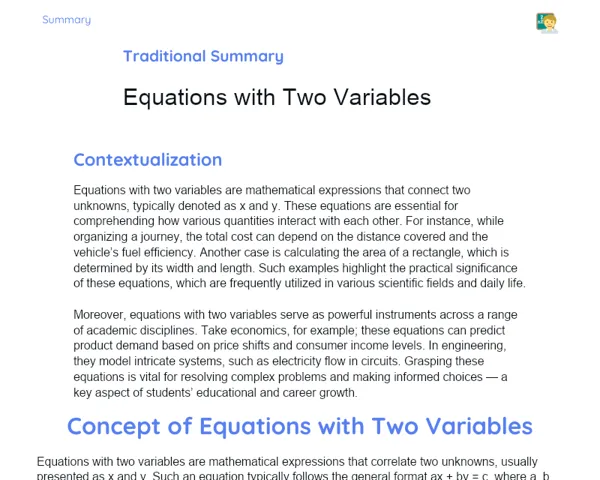Objectives
1. 🎯 Identify and apply buying and selling operations, understanding methods of payment and calculating change.
2. 🎯 Develop mental calculation skills to determine change in various buying and selling scenarios.
3. 🎯 Explore the relevance and practical application of mathematical concepts in everyday life, fostering greater financial awareness.
Contextualization
Did you know that every time you make a purchase, you're engaging in a mathematical operation? From quick snacks at the school canteen to bigger buys in the market, knowing how to calculate change and check totals is crucial. Gaining a solid grasp on these concepts not only helps you avoid errors in your transactions but also enhances your ability to make informed financial decisions. Let's dive into the world of buying and selling, applying mathematics to make a real difference in your daily life!
Important Topics
Buying and Selling
The buying and selling process is not just key in business transactions but also vital for understanding basic mathematical operations. When you buy something, you essentially subtract the item's price from the amount you have. Conversely, when you sell, you add the price received to your total amount. These operations are essential for sharpening mental math skills and comprehending how money works in transactions.
-
Buying: Subtract the item's price from your available amount. For example, if you have ₹500 and buy something for ₹200, you’ll have ₹300 left.
-
Selling: Add the cash received to your total amount. If you sell an item for ₹300 and had ₹300 before, now you have ₹600.
-
Importance in daily life: These calculations are part of all transactions, from shopping at retail stores to bargaining at local markets.
Calculating Change
Calculating change is an everyday application of addition and subtraction that comes up often in buying and selling scenarios. When you pay more for an item than its price, you’ll need to find out how much change to get back. This involves reversing the purchase process, where you deduct the item's price from the amount paid to find the change.
-
Change: This refers to the amount remaining after subtracting the cost of an item from the amount paid.
-
Practical example: If an item costs ₹150 and you pay with a ₹200 note, your change will be ₹50.
-
Skill development: Regular practice in calculating change hones your mental math skills and enhances your understanding of subtraction.
Fractions in Financial Contexts
Fractions play a crucial role in understanding and dealing with monetary amounts that are not whole numbers. In common buying and selling situations, especially for children, prices often involve amounts like ₹0.50 or ₹0.75. A solid grasp of fractions is vital for accurate change calculations and money management.
-
Value representation: Fractions depict parts of a whole, such as 1/2 (half) or 3/4 (three-quarters).
-
Calculating change: When an item's price isn’t a whole number, fractions are necessary for determining and giving the correct change.
-
Mathematical development: Working with fractions in finance supports a comprehensive understanding of fractions and prepares you for more complex calculations in the future.
Key Terms
-
Buying: The act of obtaining a good or service by making a payment.
-
Selling: The act of giving up a good or service in exchange for money.
-
Change: The amount of money returned to the buyer when they pay more than the item's cost.
-
Fraction: A portion of a whole, expressed with a numerator and denominator, used to indicate quantities that are not whole.
For Reflection
-
How can you apply buying and selling operations in your daily life beyond just transactions in shops?
-
Why is it crucial to learn how to calculate change accurately? What are the potential implications of incorrect calculations?
-
In what ways can understanding fractions boost your math skills and assist you in practical situations like buying and getting change?
Important Conclusions
-
Today, we learned how to leverage math in our daily lives through buying and selling, getting to grips with payment methods, and calculating change. These skills are vital not just in commercial interactions but also in many everyday situations.
-
Understanding how to calculate change accurately and grasping the use of fractions not only enhances your math knowledge but also fosters better financial awareness and more informed decision-making.
-
Remember, fractions help illustrate parts of a whole and are fundamental for managing situations involving non-whole amounts, like small purchases or splitting expenses.
To Exercise Knowledge
- Expense Diary: For one week, track all your purchases and try to compute the change for each one. Reflect on how to use math to manage your finances better. 2. Buying Simulation: Involve a family member to simulate purchases. Use real values and practice calculating the change. 3. Fraction Game: Create a board game where players make calculations involving fractions. This will not only reinforce the concept but also enhance your mental math skills.
Challenge
🌟 Quick Change Challenge: Use a stopwatch and see how quickly you can calculate change for a shopping list you’ve created. Challenge yourself to improve your time with each attempt!
Study Tips
-
Practice mental math each day, whether it’s by making small purchases or trying to figure out change before the cashier does.
-
Explore online games or educational apps that feature mathematical calculations in buying and selling contexts to make learning enjoyable and engaging.
-
Engage with friends or family in discussions about everyday situations involving money calculations. This can offer you different insights and techniques for tackling these scenarios.



